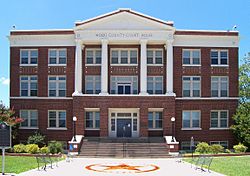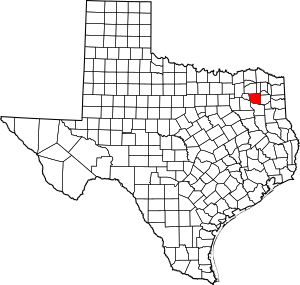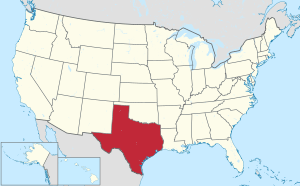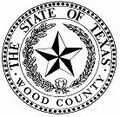Wood County, Texas facts for kids
Quick facts for kids
Wood County
|
||
|---|---|---|

The Wood County Courthouse in Quitman
|
||
|
||

Location within the U.S. state of Texas
|
||
 Texas's location within the U.S. |
||
| Country | ||
| State | ||
| Founded | 1850 | |
| Named for | George Tyler Wood | |
| Seat | Quitman | |
| Largest city | Mineola | |
| Area | ||
| • Total | 695.719 sq mi (1,801.90 km2) | |
| • Land | 645.234 sq mi (1,671.15 km2) | |
| • Water | 50.484 sq mi (130.75 km2) 7.3% | |
| Population
(2020)
|
||
| • Total | 44,843 | |
| • Density | 64.4556/sq mi (24.88645/km2) | |
| Time zone | UTC−6 (Central) | |
| • Summer (DST) | UTC−5 (CDT) | |
| Congressional district | 5th | |
Wood County is a county located in the U.S. state of Texas. In 2020, about 44,843 people lived there. Its main government center, called the county seat, is Quitman. The county was named after George T. Wood, who was the governor of Texas from 1847 to 1849.
Contents
History of Wood County
Early Explorers and First Settlers
The first Europeans to explore the area that is now Wood County were led by Pedro Vial in the late 1700s. He was sent on trips by the Spanish governor of Texas. In 1788, he traveled through this area on his way back to San Antonio.
Some old findings suggest that a French trading post might have been here in the early 1700s. It was near where the town of Hainsville is today. There might have even been a French military post called Fort Ledout near Black Oak. However, we don't know much about these possible French settlements.
In 1887, a group found some interesting items southeast of Hainsville. These items included a cross, parts of tomahawks, a Spanish coin, and broken muskets. This suggests there might have been a battle between Native American tribes or with the Spanish. But there are no written records of such a fight.
Not many people settled here until after the Texas Revolution. The first known White settler was Martin Varner, who built his home near Hainsville by 1824. The first organized town was Webster, started in 1845.
How Wood County Was Formed
Wood County was officially created in 1850, after Texas joined the United States. Before that, this area was part of Van Zandt County. People living north of the Sabine River found it hard to travel to the county seat, especially in winter. So, they asked the government to create a new county. That's how Wood County was formed!
Early Businesses and Growth
In the early days, Wood County had many sawmills, which cut wood, and gristmills, which ground grain. There were also steam mills and cotton gins. A factory that made jugs operated in the 1850s. Another jug factory was built later, and two brick kilns were in the Winnsboro area.
A furniture company started in Mineola in 1874. Making chairs from cane and rawhide also became a business in 1886. When railroads arrived in the 1870s, cutting railroad ties became a big industry. Towns like Pine Mills and Perryville grew because of these sawmills.
Wood County During the Civil War
In 1850, Wood County had only 17 enslaved people. But by 1860, this number grew to 923, making up about 20% of the population. When it came time to vote on leaving the United States, Wood County voted to secede by a large majority. However, the two people sent to the Secession Convention from Wood County actually voted against leaving.
The first soldiers from Wood County to join the Confederacy were part of the 10th Texas Cavalry Regiment. A training camp called Camp Flournoy was set up near Quitman. Another group, the Wood County Rebels, formed in 1861 and asked to serve as cavalry.
Railroads Arrive
The arrival of railroads changed Wood County a lot. In 1873, the Texas and Pacific Railroad came through the southern part of the county. It met another railroad line in a place called Sodom, which was later renamed Mineola. This connected the county to bigger cities like Longview and Dallas.
More railroads came to the northern part of the county in 1876. These new lines helped transport goods and people, making it easier for businesses to grow.
Discoveries of Coal and Oil
Around 1900, coal was found in the Alba area. The mines here dug up lignite coal. Later, in 1941, oil was discovered in Wood County! By 1948, the county was producing a huge amount of oil each year. Important oilfields include the Pine Mills Oilfield and the Alba Oilfield.
Geography and Nature
Wood County covers about 695 square miles. Most of this area is land, but about 7.3% is covered by water, including lakes and rivers.
Neighboring Counties
Wood County shares its borders with several other counties:
- Hopkins County (to the north)
- Franklin County (to the northeast)
- Camp County (to the northeast)
- Upshur County (to the east)
- Smith County (to the south)
- Van Zandt County (to the southwest)
- Rains County (to the west)
Protected Natural Areas
The county is home to the Little Sandy National Wildlife Refuge. This is a special area set aside to protect wildlife and their natural homes.
Communities in Wood County
Wood County has several towns that have their own elected governments. These are called municipalities or incorporated towns. There are also many smaller communities that are not officially incorporated but are still active settlements.
Towns with Local Governments
Other Communities and Settlements
- Cartwright
- Coke
- Crow
- East Point
- Forest Hill
- Fouke
- Golden
- Hainesville
- Hoard
- Little Hope
- New Hope
- Oak Grove
- Ogburn
- Perryville
- Pine Mills
- Pineview
- Pleasant Grove
- Stout
Population and People
The population of Wood County has changed over the years. In 1860, there were about 4,968 people. By 2020, the population had grown to 44,843.
Population Changes Over Time
| Historical population | |||
|---|---|---|---|
| Census | Pop. | %± | |
| 1860 | 4,968 | — | |
| 1870 | 6,894 | 38.8% | |
| 1880 | 11,212 | 62.6% | |
| 1890 | 13,932 | 24.3% | |
| 1900 | 21,048 | 51.1% | |
| 1910 | 23,417 | 11.3% | |
| 1920 | 27,707 | 18.3% | |
| 1930 | 24,183 | −12.7% | |
| 1940 | 24,360 | 0.7% | |
| 1950 | 21,308 | −12.5% | |
| 1960 | 17,653 | −17.2% | |
| 1970 | 18,589 | 5.3% | |
| 1980 | 24,697 | 32.9% | |
| 1990 | 29,380 | 19.0% | |
| 2000 | 36,752 | 25.1% | |
| 2010 | 41,964 | 14.2% | |
| 2020 | 44,843 | 6.9% | |
| U.S. Decennial Census 1850–2010 2010 2020 |
|||
Diversity in Wood County
Wood County is home to people from many different backgrounds. In 2020, most residents were White. There are also communities of Black or African American, Native American, Asian, and people of mixed races. A growing number of residents are of Hispanic or Latino heritage.
Getting Around: Transportation
Wood County is connected by important roads and railways. Two major U.S. highways, US 69 and US 80, meet in downtown Mineola. Texas Highway 37 also connects Mineola and Quitman.
Main Roads
 U.S. Highway 69
U.S. Highway 69 U.S. Highway 80
U.S. Highway 80 State Highway 11
State Highway 11 State Highway 37
State Highway 37 State Highway 154
State Highway 154 State Highway 182
State Highway 182
Farm to Market Roads
These roads help connect rural areas to towns and cities. Wood County has many of them:
Railways and Airports
The Amtrak passenger train, called the Texas Eagle, travels through Wood County. The train tracks are owned by Union Pacific.
Wood County also has three airports:
- Mineola Wisner Field (3F9)
- Wood County Airport (Mineola/Quitman Airport)
- Winnsboro Municipal Airport
News and Media
Wood County has local newspapers and radio stations that keep residents informed.
Newspapers
There are five newspapers published in Wood County: Wood County Now, Wood County Monitor, Winnsboro News, Yantis Tymes, and The Community Chronicle.
- Wood County Monitor
In 2016, two older newspapers, the Mineola Monitor and the Wood County Democrat, joined together to become the Wood County Monitor.
- Winnsboro News
The Winnsboro News started in 1908. It is a weekly newspaper that serves both Wood and Franklin Counties.
- Wood County Now
Wood County Now began in 2020 during the coronavirus pandemic. It's a free online news source that shares information on social media. It quickly became a very popular news source in the county.
Radio Stations
Wood County has two local radio stations:
- KWNS is a Southern Gospel music station in Winnsboro, broadcasting at 104.7 FM.
- KMOO is a country music station in Mineola, broadcasting at 99.9 FM. It was founded in 1963.
Education and Learning
Early Schools
In the past, Wood County had "subscription schools" where families paid tuition. By 1854, free public schools started to become more common in Texas. In 1884, the Texas government divided the county into official free public school districts. Separate school districts were also set up for African American students.
School Districts Today
Today, parts of Wood County are served by 11 different independent school districts. These districts provide education from pre-kindergarten through 12th grade.
- Alba-Golden ISD
- Big Sandy ISD
- Como-Pickton CISD
- Harmony ISD
- Hawkins ISD
- Mineola ISD
- Pittsburg ISD
- Quitman ISD
- Union Hill ISD
- Winnsboro ISD
- Yantis ISD
Colleges and Universities
Jarvis Christian College is a college located in the unincorporated part of Wood County, near Hawkins.
Culture and Landmarks
Wood County has many historic and natural sites. Some places have special designations from state and national groups.
Historic Sites
- Mineola Downtown Historic District: This area in Mineola is recognized for its historic buildings.
- Mineola and Winnsboro are both "Main Street cities," meaning they work to preserve and revitalize their historic downtown areas.
Recognized Businesses and Institutions
Some businesses and institutions in Wood County have received special awards from the Texas Historical Commission for their long history and importance.
- Broadway Barber Shop (Mineola)
- Wisener Field (Mineola)
- First National Bank of Winnsboro
- R.H. McCrary Hardware (Winnsboro)
Notable People from Wood County
Many interesting people have come from Wood County, including:
- Willie Brown, a well-known politician from California.
- Bryan Hughes, a Texas state representative.
- Bobby Ray Inman, a U.S. Navy Admiral.
- Ray Price, a famous country music singer and songwriter.
- Harold Simmons, a billionaire businessman.
- Sissy Spacek, an Academy Award-winning actress.
- Kacey Musgraves, a popular musician.
- Mack Tuck, a professional basketball player and coach.
Images for kids
See also
 In Spanish: Condado de Wood (Texas) para niños
In Spanish: Condado de Wood (Texas) para niños




